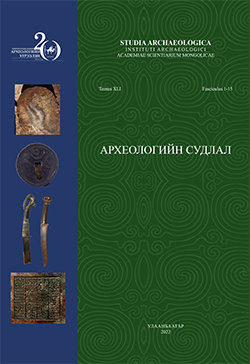The study of bronze knifes at the museum of Dundgovi and Umnugovi provinces
DOI:
https://doi.org/10.5564/sa.v41i1.2480Keywords:
Bronze knifes, Eurasia, nomadic pastoralism of Bronze Age, change in material cultureAbstract
The development and changes of nomadic pastoralism during the Bronze Age (2nd-1st millennium BCE) have become the main research focus of many scholars around the world. Especially the territory between southern Siberia and Inner Mongolia plays a significant role in understanding the prehistoric cultural landscape as it contains various archaeological monuments from different time periods. In this article, we present our research on bronze knifes collected from the ground surface. We focus on changes in the typology and design of these knives, which are essential tools of nomadic communities.
Therefore, bronze knifes are important artifacts that can shed light on the technological advances of ancient nomadic people. We studied designs and production methods of bronze knifes and traced changes over time since the 1st millennium BCE. Our analysis demonstrates a noticeable change in knifes. We suggest that the changes might have been triggered by the formation of equestrian nomadic cultures as well as environmental changes.
Дундговь, Өмнөговь аймгийн музейд хадгалагдаж буй хүрэл хутганы судалгаа
Товчлол. Сүүлийн жилүүдэд НТӨ II-I мянган жил буюу хүрлийн үеийн нүүдэлчдийн соёлын үүсэл, хөгжлийн онцлогтой холбогдох олон төрлийн эх хэрэглэгдэхүүний судалгаа эрчимтэй хийгдсээр байна. Хүрэл зэвсгийн үед холбогдох археологийн дурсгалууд Монгол оронд элбэг бөгөөд Евроазийн бүс нутагт тархсан олон янзын соёлуудын харилцан хамаарлын асуудлыг тодруулахад өмнөд Сибириэс Цагаан хэрмийн бүс нутаг хүртэлх газар нутгийн судалгаа нь чухал байр суурийг эзэлдэг билээ.
Энэхүү өгүүлэлд монгол орны өмнөд бүс нутгаас түүврээр олдсон хүрэл хутганы хэлбэрийн өөрчлөлтийн талаар хийсэн судалгааг та бүхэнд толилуулж байна. Хүрэл хутга нь нүүдэлчин ард түмний өдөр тутмын амьдралд чухал үүрэгтэй төдийгүй түүнийг хийсэн технологийн арга барил, шинж чанарыг нь судлах боломжийг олгодог. Судалгаанд хамрагдсан хүрэл хутганы үйлдвэрлэл, хийх арга зүй, хэлбэрийг судалсны үр дүнд НТӨ I мянганы эхэн үеэс хойш хүрэл хутганы хийц, хэлбэрт ямар өөрчлөлтүүд гарсныг тогтоохыг зорилоо.
Түлхүүр үгс. Хүрэл хутга, Евроазийн бүс нутаг, хүрэл зэвсгийн үеийн нүүдлийн соёл, үйл ажиллагааны өөрчлөлт
Downloads
288
Downloads
Published
How to Cite
Issue
Section
License
Copyright (c) 2023 K.Matsumoto, Ts.Amgalantugs, L.Ishtseren

This work is licensed under a Creative Commons Attribution-NonCommercial 4.0 International License.
Copyright on any research article in the Studia archeologica is retained by the author(s).
The authors grant the Studia archeologica license to publish the article and identify itself as the original publisher.
![]()
Articles in the Studia archeologica are Open Access articles published under a Creative Commons Attribution-NonCommercial 4.0 International License - CC BY NC.
This license permits use, distribution and reproduction in any medium, provided the original work is properly cited.




